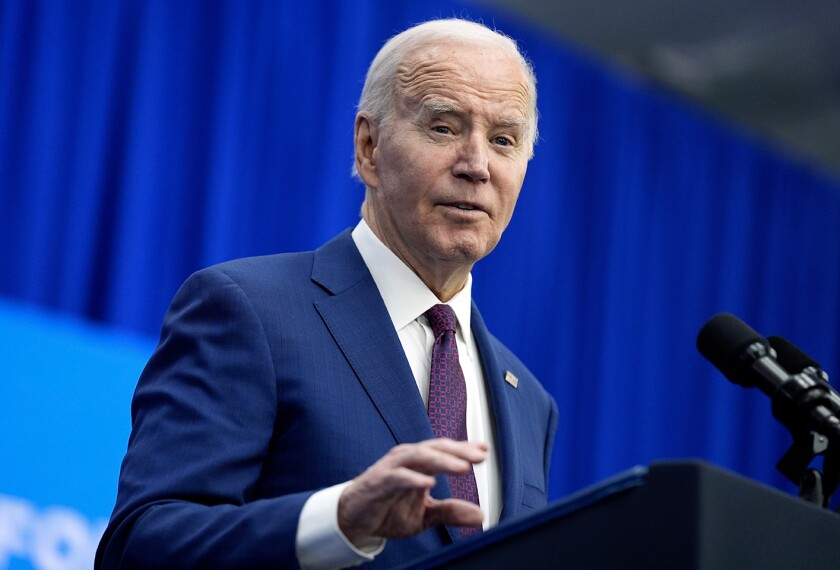If action in the House of Representatives last week was any indication, a trend is emerging on federal education spending: The total keeps climbing, but by smaller and smaller percentage increments each year.
The Republican-controlled chamber on Sept. 9 approved $57.7 billion in discretionary spending for the Department of Education in fiscal 2005. The amount was up $2 billion, or 3.6 percent, over the current fiscal year, which ends Sept. 30. The bill advanced on a vote of 388-13.
The appropriations measure largely reflects President Bush’s spending priorities, with $1 billion increases for special education and the Title I program for disadvantaged students, as well as matching his requests for Reading First, state assessments, and many other programs.
But, as is always the case, lawmakers weren’t prepared to go along with all of the president’s ideas. Indeed, his GOP allies in the House rebuffed some ideas Mr. Bush has been pushing in his re-election campaign, such as creating “Enhanced Pell Grants” that would provide a bigger college-aid grant to low-income students who took a rigorous high school curriculum.
The action on the education spending bill came as Congress returned from its summer recess last week to face a raft of unfinished education business in other areas, such as bills to reauthorize the nation’s main special education law, as well as the Higher Education Act, Head Start, and the vocational education law.
But the prospects for final action on any of those fronts appear to be slim, at least before Election Day. Some are holding out hope, however, that perhaps in a lame-duck session after Nov. 2, lawmakers might at least wrap up the reauthorization of the Individuals with Disabilities Education Act. Separate versions have passed in the House and Senate, and the measure awaits a final negotiation between the two chambers.
‘Focus on Education’
The Education Department budget, passed as part of a larger spending bill that also covers the departments of Labor and Health and Human Services, offers a smaller percentage increase for fiscal 2005 than has been seen the past several years.
In fiscal 2004, the department’s budget climbed by 4.8 percent, and the year before that, 6.4 percent. Both of those figures, however were dwarfed by the 18.2 and 18.6 percent increases in fiscal years 2002 and 2001, respectively.
While the Bush administration often emphasizes the tremendous growth in federal education spending in recent years, time and again Congress has taken the spending level above the president’s request, often by billions. This year’s House budget bill was no exception, as Rep. Ralph Regula, R-Ohio, who chairs the House subcommittee that oversees education spending, made clear.
“We had to make some very tough priority choices to stay within the constraints of the budget resolution,” he said on the House floor last week. “A policy decision we made was to focus on education, and we put $342 million more into education programs than was requested in the president’s budget.”
But Democrats weren’t impressed.
“This bill is a monument to broken promises and is an embarrassment to the institution,” Rep. David R. Obey of Wisconsin, the top Democrat on the Appropriations Committee, said on the floor. “For Title I alone, this bill is $7 billion short of the promises laid out in the No Child Left Behind Act.”
Despite such misgivings, most Democrats, including Mr. Obey, ultimately voted for the bill. Democrats claimed a victory with the approval of a floor amendment that would block new Bush administration rules on overtime pay from taking effect. They have vowed to continue pushing for higher spending for education.
Rep. John A. Boehner, R-Ohio, the chairman of the House Education and the Workforce Committee, has emphasized that Democrats themselves apparently aren’t willing to match the authorized levels in the No Child Left Behind law.
Indeed, an amendment by Rep. Obey to the spending bill would have provided an extra $5.5 billion for the Education Department, not enough to meet the full authorization levels for Title I and other key programs. The amendment, which also would have stepped up spending in other areas and was offset by rolling back recent tax cuts for individuals earning more than $1 million, was defeated in committee, and Republicans wouldn’t allow a floor vote on it.
Adjunct Teacher Corps
Although the House bill deferred to many of the president’s wishes, it parted company on a range of issues, offering more or less funding for particular items or even not giving any money to something the president wanted.
One idea President Bush proposed as part of his fiscal 2005 budget request, and which is also highlighted on his campaign Web site, would reserve $33 million in Pell Grant funds for an Enhanced Pell Grant, which could provide up to $1,000 above the current maximum award of $4,050. In the House spending plan, that item gets zapped.
The president also wants to create a $40 million Adjunct Teacher Corps aimed at recruiting professionals to teach specific high school courses, whether part-time, full-time while on leave from their usual jobs, or through online or distance-learning arrangements. Here, too, the House bill provides no funding.
At the same time, in other areas the House bill provides money Mr. Bush didn’t seek. The president called for abolishing dozens of programs. But the House would retain the Even Start family literacy program at $247 million, provide $80 million for Comprehensive School Reform Program (well below the $234 million in the current fiscal year), and $11 million for the Javitz Gifted and Talented Program, among others.
No action has been taken yet in the Senate on the spending bill.
As for the education reauthorization bills, the future is uncertain.
“I’m hard pressed to see anything making it to the finish line until after the election,” said Vic Klatt, a lobbyist with Van Scoyoc Associates in Washington and a former top education aide to Republicans on the House education committee. “I just don’t see it.”




